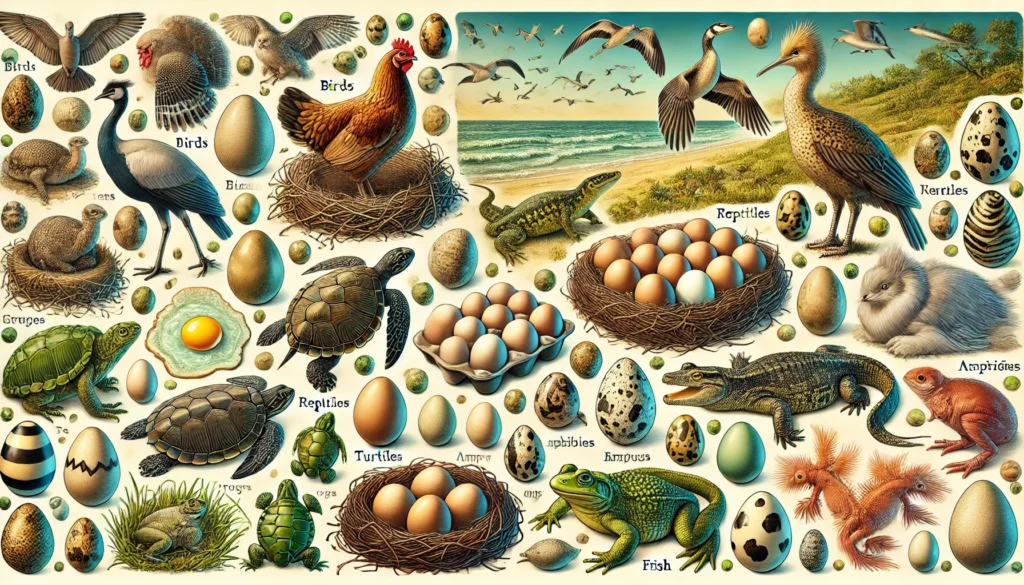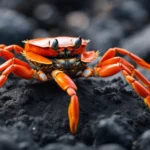While many animals give birth to live young, a wide variety of creatures across different species and habitats lay eggs. From reptiles to birds, fish to insects, egg-laying is a reproductive strategy that has allowed animals to thrive for millions of years. In this article, we’ll explore ten amazing animals that lay eggs, uncovering the fascinating adaptations that help these species ensure the survival of their offspring.
1. Sea Turtles
One of the most iconic egg-laying animals is the sea turtle. These ancient reptiles have been laying eggs on beaches around the world for more than 100 million years. Female sea turtles return to the shores where they were born to dig nests and lay their eggs, a journey known as natal homing.
Once the female has laid her clutch of about 50 to 200 eggs (depending on the species), she covers them with sand and returns to the ocean. The eggs incubate for about two months before hatching. Hatchlings instinctively head towards the ocean, where they will begin their perilous journey to adulthood, facing threats from predators and human activities.
Survival Strategy
Sea turtles lay large numbers of eggs because the survival rate is very low—many hatchlings are eaten by predators before they reach the ocean, and even fewer survive to adulthood. This reproductive strategy ensures that at least a few will survive and continue the species.
2. Chickens
Perhaps the most familiar egg-laying animal is the chicken. Domestic chickens have been bred for thousands of years for their eggs and meat, making them one of the most economically important animals worldwide. Female chickens, or hens, lay eggs regularly, whether or not they are fertilized.
Chickens typically lay one egg per day, and if fertilized, the egg will develop into a chick. If not, the egg can still be used as a food source for humans. Chickens incubate their fertilized eggs for about 21 days before the chicks hatch.
Egg-Laying and Broodiness
Not all hens will incubate their eggs. Some hens, known as broody hens, will sit on their eggs to keep them warm, while others will leave their eggs in the nest. Humans often incubate chicken eggs artificially in incubators to ensure proper development.
3. Snakes
Most species of snakes lay eggs, although some give birth to live young. Snakes that lay eggs are known as oviparous. After mating, the female snake will seek out a safe and warm location to lay her eggs, which are typically soft-shelled and leathery rather than hard like bird eggs.
Once the eggs are laid, the female may guard them or leave them to develop on their own, depending on the species. The young snakes hatch fully developed, ready to begin their lives independently.
Python Parenting
Unlike most snake species, female pythons are known to coil around their eggs to protect them and regulate their temperature, a behavior known as brooding. Pythons will stay with their eggs until they hatch, ensuring that the eggs remain safe and warm.
4. Frogs
Frogs are famous for their unique life cycle, which begins when the female lays thousands of eggs in water. The eggs are typically laid in clusters, known as spawn, and are often surrounded by a jelly-like substance that protects them from predators and drying out.
Once the eggs hatch, the young frogs, called tadpoles, emerge. These tadpoles live in the water, breathing through gills and feeding on algae until they undergo metamorphosis, eventually transforming into adult frogs with lungs and legs.
Rapid Development
Frog eggs must develop quickly to survive. In many species, the eggs hatch into tadpoles within a few days, giving the young frogs a better chance of avoiding predators.
5. Octopuses
Among marine animals, octopuses stand out as extraordinary egg layers. After mating, the female octopus lays thousands of small eggs, attaching them to a safe spot in a cave or crevice. She then carefully tends to the eggs, cleaning them and ensuring a steady flow of oxygenated water over them until they hatch.
The devotion of a mother octopus is remarkable—she will not eat during this period and often dies shortly after the eggs hatch, leaving the young octopuses to fend for themselves.
High Mortality Rates
Despite laying thousands of eggs, only a small percentage of octopus hatchlings survive to adulthood. Predators and environmental factors take a heavy toll, making the large number of eggs necessary for the continuation of the species.
6. Crocodiles
Crocodiles are another group of reptiles that lay eggs, typically in large nests made of vegetation or sand. Female crocodiles are known for their maternal instincts, carefully guarding their nests and even helping the hatchlings reach the water once they emerge from the eggs.
The temperature of the nest determines the sex of the offspring. Warmer temperatures tend to produce males, while cooler temperatures produce females.
Guarding the Young
Crocodile mothers are highly protective of their eggs and young. After the eggs hatch, the mother often carries the young in her mouth to the water, where they begin their lives under her watchful eye.
7. Penguins
Among birds, penguins are some of the most dedicated egg layers. Most species of penguins lay one or two eggs, which are incubated by both parents in turn. Penguins face harsh conditions, especially those living in Antarctica, and have adapted to keep their eggs warm in freezing temperatures.
In emperor penguins, the males take over incubation duties entirely, balancing the egg on their feet and covering it with a flap of skin called the brood pouch. The males fast for up to two months while the female returns to the ocean to feed.
Teamwork
Penguin parents share the responsibilities of egg incubation and chick-rearing. This cooperation is essential for survival in the harsh environments they inhabit, particularly in species like the emperor penguin.
8. Praying Mantis
Among insects, the praying mantis is a well-known egg layer. After mating, the female mantis lays hundreds of eggs in a frothy substance, which hardens to form a protective case called an ootheca. The eggs develop inside the ootheca over several weeks, and when the time comes, tiny mantises emerge fully formed.
Praying mantises are carnivorous from the moment they hatch, feeding on small insects and growing rapidly. The survival of young mantises depends on their ability to find food quickly and avoid being eaten by larger predators.
Cannibalistic Tendencies
Interestingly, some species of praying mantises exhibit cannibalism, with newly hatched mantises sometimes feeding on each other if food is scarce.
9. Sharks
While most sharks give birth to live young, a few species, like the horn shark and zebra shark, lay eggs. These shark eggs are often encased in a tough, leathery shell known as a mermaid’s purse, which protects the developing embryo inside.
The eggs are typically laid in crevices or attached to underwater structures, where they are safe from predators. After several months, the young sharks hatch fully formed and ready to swim off on their own.
Mermaid’s Purse
The unique shape and structure of shark eggs, commonly referred to as a mermaid’s purse, are designed to protect the embryo from predators and harsh ocean conditions, ensuring the young shark has the best chance of survival.
10. Monarch Butterflies
The monarch butterfly is not only famous for its long migrations but also for its fascinating reproductive cycle. Female monarchs lay their eggs exclusively on milkweed plants, which provide food for the caterpillars once they hatch.
Each female can lay hundreds of tiny, cream-colored eggs over her lifetime. After a few days, the eggs hatch into caterpillars, which begin feeding on the milkweed. These caterpillars eventually transform into butterflies through the process of metamorphosis.
A Life of Transformation
Monarch butterflies undergo one of the most remarkable transformations in the animal kingdom. From egg to caterpillar to chrysalis and finally to adult butterfly, their life cycle is a testament to nature’s complexity and beauty.
Conclusion
Egg-laying is a reproductive strategy that spans across a wide range of animal species, from reptiles and birds to insects and marine creatures. While the specifics of egg-laying may differ from species to species, the goal remains the same: to ensure the survival of the next generation. Whether it’s a sea turtle burying her eggs in the sand or a crocodile guarding her nest, these animals demonstrate the incredible diversity and ingenuity of life on Earth.
FAQ
Why do some animals lay eggs?
Laying eggs is a reproductive strategy that allows animals to produce offspring without the need for live birth. It can be advantageous in certain environments, as it enables parents to produce large numbers of offspring, increasing the chances that some will survive.
Are all reptiles egg-layers?
No, not all reptiles lay eggs. While most reptiles, such as snakes and turtles, are oviparous (egg-layers), some species of snakes and lizards give birth to live young, a reproductive strategy known as viviparity.
How do sharks lay eggs?
Some species of sharks lay eggs that are encased in a tough, leathery shell known as a mermaid’s purse. These eggs are usually deposited in safe locations like crevices or attached to underwater plants, where they remain until the young sharks hatch.
Do all birds lay eggs?
Yes, all birds lay eggs. Birds are oviparous, and their eggs are often hard-shelled to protect the developing chick inside. Bird parents typically incubate their eggs to keep them warm until they hatch.
What is the purpose of the jelly around frog eggs?
The jelly surrounding frog eggs serves to protect the eggs from predators and drying out. It also helps keep the eggs anchored in place in the water, where they can safely develop into tadpoles.
Can insects lay eggs?
Yes, most insects lay eggs. Insects like butterflies, ants, and praying mantises lay hundreds of eggs during their lifetimes. These eggs develop into larvae or nymphs, depending on the species, before reaching adulthood.


